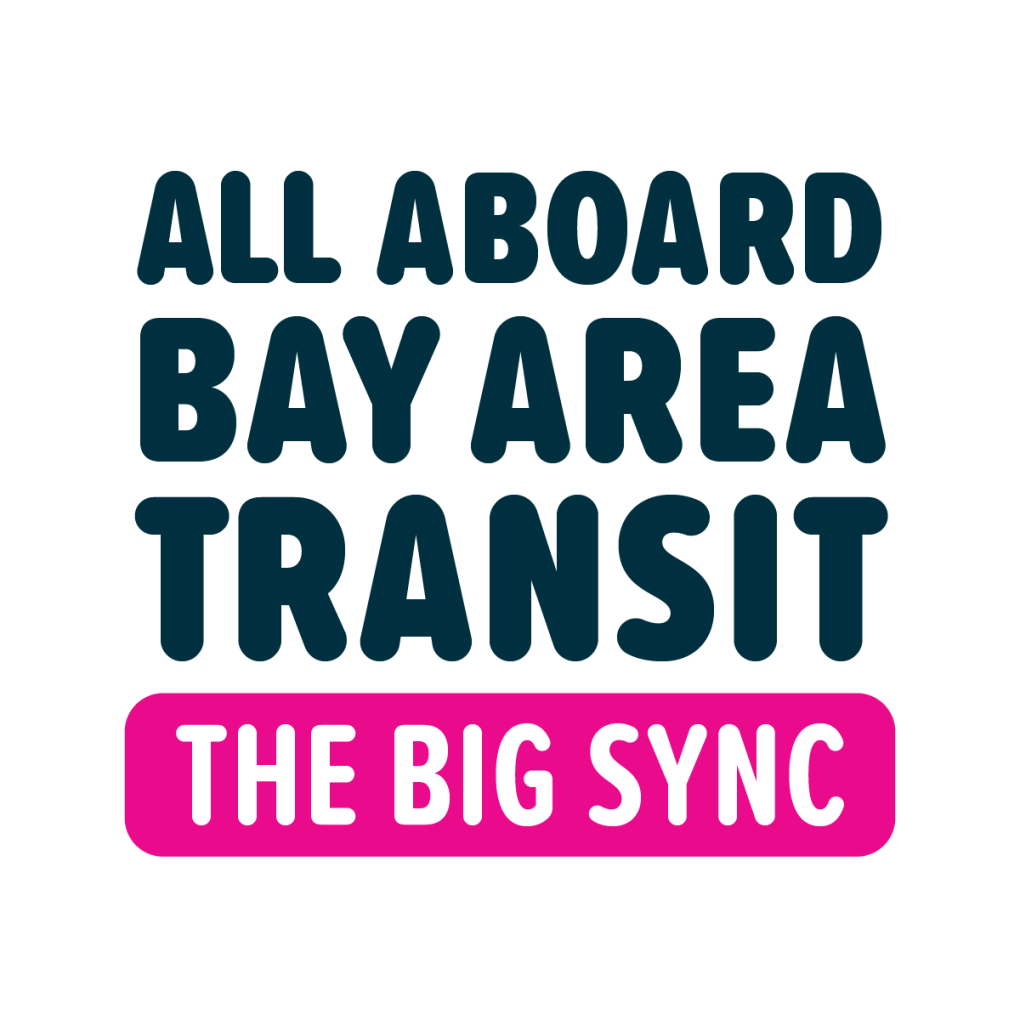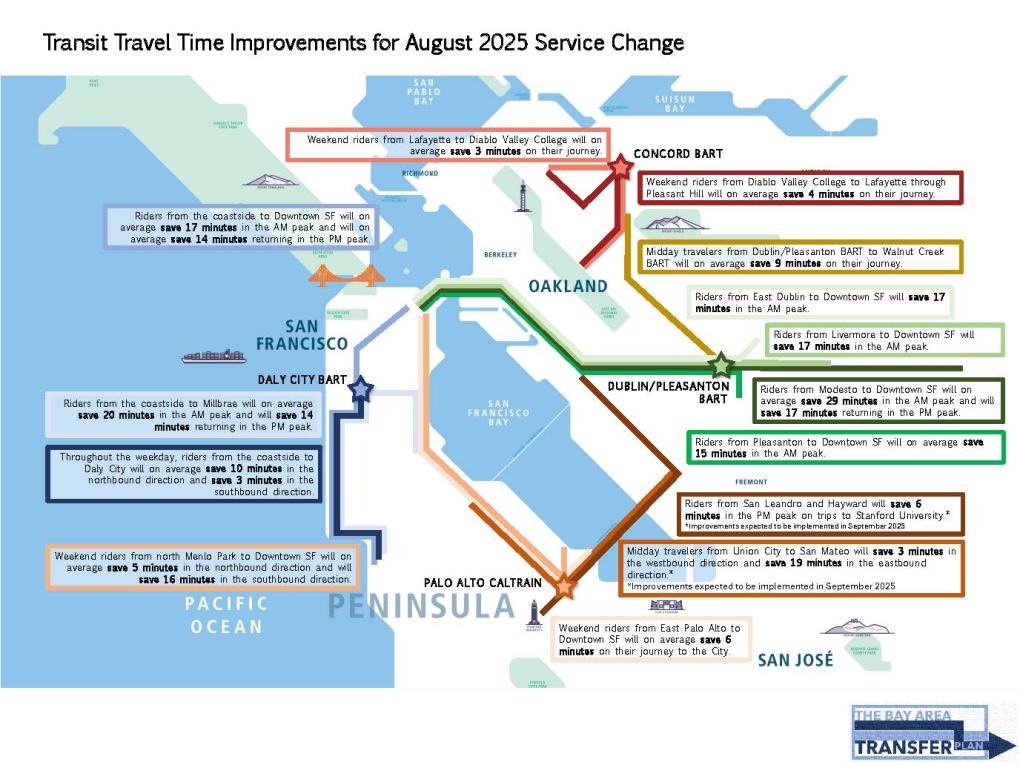Bay Area transit’s latest Big Sync improves transfers, saving riders up to 20 minutes per trip

Bay Area transit agencies have been syncing schedules in a whole new way to make riding transit even faster. Transit agencies from across the region are updating their schedules at the same time in mid-August to significantly improve transfer reliability and timing. With these changes, transit riders who use more than one system will see a variety of improvements across the Bay Area this month, saving some riders as much as 20 minutes on their trips.
This is the third iteration of a coordinated Big Sync in the Bay Area. Agencies meet several months in advance of each schedule change to share planned changes and to look for opportunities to improve transfers.
Four transfer hubs get schedule overhauls
After a thorough analysis of potential high-impact improvements benefiting the greatest number of riders, four specific locations where riders transfer from one system to another were prioritized for changes to maximize efficiency:
- Dublin/Pleasanton BART
- Daly City BART
- Palo Alto Caltrain
- Concord BART
These transfer hubs involved the coordination of BART, Muni, SamTrans, Caltrain, VTA, Dumbarton Express, Stanford Marguerite, Tri Delta Transit, County Connection, StanRTA, and LAVTA’s Wheels.
In all, 18 bus routes at the four hub locations were tweaked to improve transfer connections with BART, Caltrain, and with each other. For these 18 routes, this effort achieves a 33% increase in weekday ideal transfers, most commonly between 5-10 minutes, and a 47% increase in weekend ideal transfers.
When a transfer window is too short, riders must sprint to make their connection, or worse, they just miss it and have a long wait. This effort achieves a 23% decrease in weekday transfers that are too short and a 36% decrease in weekday transfers that are too long.
Advancing schedule change alignment is a key priority for Bay Area transit general managers, who meet on a weekly basis to make transit more rider-focused and efficient.
“The Big Sync was born from the idea that while we are separate agencies by name, we all work as one to serve the region,” said BART General Manager Bob Powers, who leads a Monday morning call with all operators with a focus on coordination and transformational improvements. “Bay Area transit agencies are maximizing our limited resources by working collaboratively to speed up travel times across the region and make it easier to ride the bus, train, or ferry.”

Some of the biggest travel time savings from this Big Sync include:
Peninsula Travel Time Improvements
- Riders from the Peninsula coastside to Millbrae will on average save 20 minutes in the morning peak and will save 14 minutes returning in the evening peak for those who take SamTrans #117, SamTrans #110, and BART.
- Riders from the Peninsula coastside to Downtown San Francisco will on average save 17 minutes in the morning peak and on average save 14 minutes returning in the evening peak for those who take SamTrans #117 or SamTrans #110, and BART.
- Midday riders from Union City to San Mateo will save 3 minutes in the westbound direction and 19 minutes in the eastbound direction for those who take Dumbarton Express and Caltrain beginning in September.
East Bay Travel Time Improvements
- Riders from East Dublin to Downtown San Francisco will save 17 minutes in the morning peak for riders who take LAVTA’s Wheels #2 and BART.
- Riders from Pleasanton to Downtown San Francisco will on average save 15 minutes in the morning peak for riders who take LAVTA’s Wheels #8 and BART.
- Riders from Livermore to Downtown San Francisco will save 17 minutes in the morning peak for riders who take LAVTA’s Wheels #10R and BART.
Other transit service coordination efforts for August include:
- BART trains will have a longer dwell time at Millbrae Station for improved reliability of Caltrain and SamTrans connections.
- BART trains will have a longer dwell time at Dublin Station for improved LAVTA Wheels connections.
- BART will have more even train spacing between the Orange & Green lines from Berryessa to Richmond for improved connections with VTA, AC Transit, and Union City Transit bus service.
- Muni is offering more morning service on the 49 Van Ness/Mission, 30x Marina Express and 1x California Express that connect to BART and the Salesforce Transit Center based on feedback from their riders.
- VTA’s 500 bus at Berryessa BART will shift to align with BART’s new schedule.
- County Connection Route 35 at Dublin/Pleasanton BART will shift to align with the new BART schedule. In June, County Connection implemented changes to weekend routes 310, 314, and 320 to improve bus-bus connections at Concord BART.
- AC Transit has updated 104 bus lines as part of the all-new Realign network. Realign brings a range of improvements, including coordinated scheduling to support smoother transfers to BART and expanded service for better connections with Golden Gate Transit. Developed over two years with an equity focus, Realign right-sizes their bus network to address fiscal challenges while remaining flexible to meet the evolving travel needs of East Bay riders.
- Tri Delta Transit is making changes to several routes to better align with BART, County Connection, and WestCAT as part of a new “TDT Network” revitalized system update, with feedback from their riders, offering more frequent, efficient, and faster service.
- SamTrans is updating schedules for routes 110, 121, SKY and PCX in the Daly City area to better align with BART arrivals and departures. Farther down on the Peninsula, routes 280 and 281 will shift to better connect with Caltrain service at the Palo Alto Transit Center.
- Caltrain continues to work and meet with BART, VTA, and SamTrans to improve transfers. By sharing data and rider patterns with our partners, we were able to collaboratively sync up several routes that connect at the Palo Alto Transit Center and Caltrain Station, greatly reducing travel times. Because of that, ideal transfer connections have jumped from 44 to 146 and those that were too long or too short have dropped from 106 to just a couple dozen.